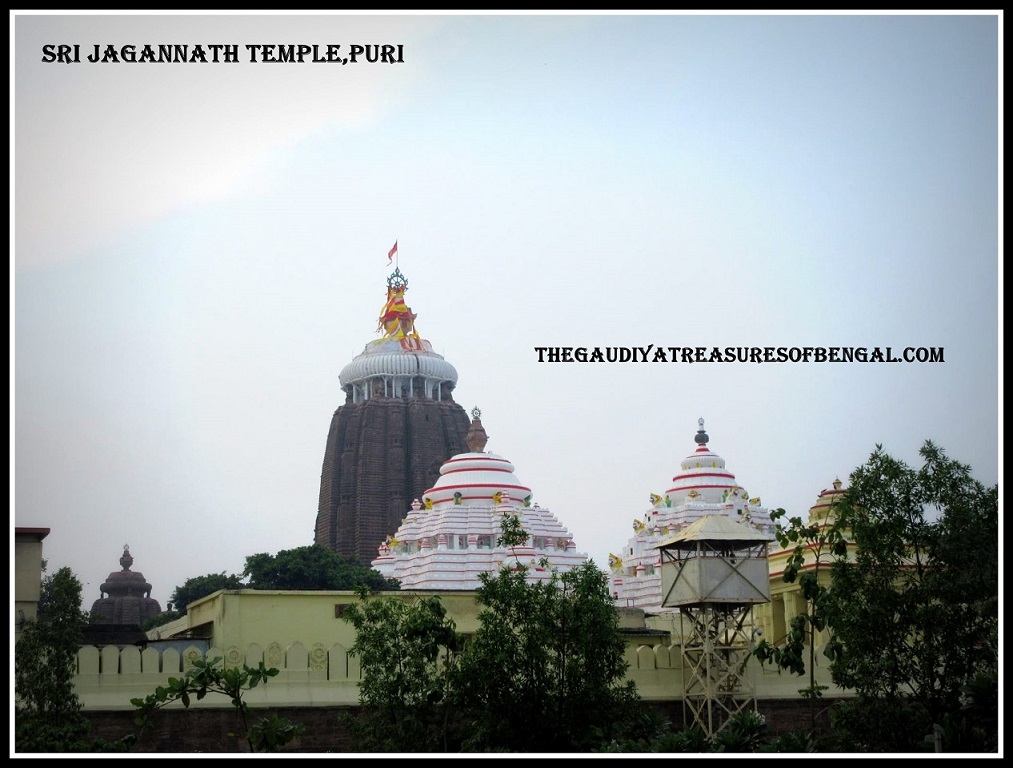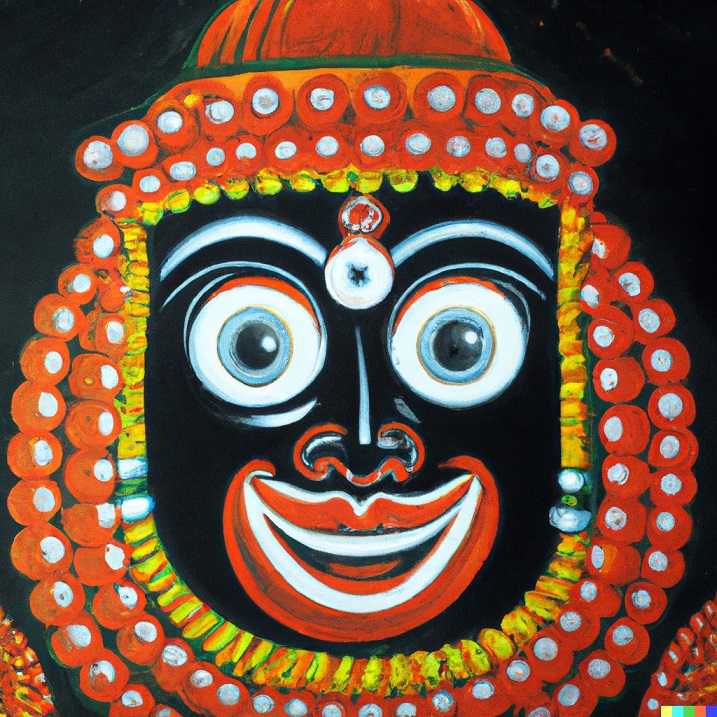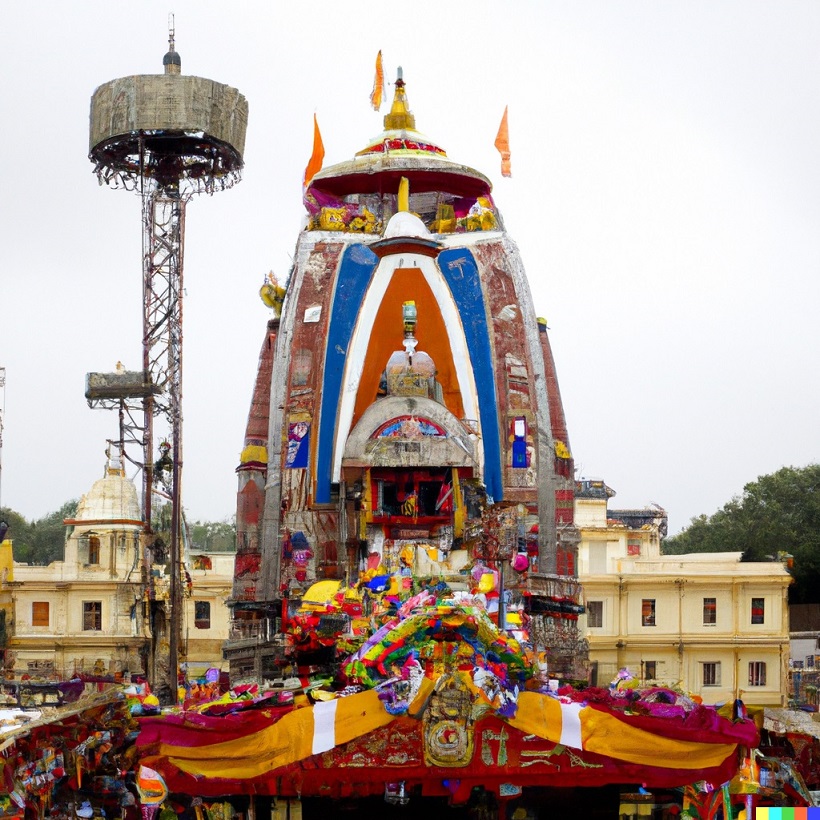
The holy site of Jagannath Puri is known by several names such as Sri Kshetra, Purushottama Kshetra, Nilachala Dham, Jagannath Dham, Samanik Tirtha, Uddiyan Pith, Marta-Vaikuntha, Nilgiri, Niladri, Sankha Kshetra, Bhu-svarga, and Nrsimha Kshetra. Regarded as one of India’s (Bharat) foremost spiritual destinations, it is believed that the Supreme Lord Sri Vishnu takes a bath at Badrinath in North India, changes His attire in Dwarka in West India, enjoys His meals in Jagannath Puri in East India, and retires to Rameshwaram in South India. In Jagannath Puri, the Supreme Lord is worshiped in the form of His deity. A sighting of the Lord is said to grant one liberation from the material world, and visiting Jagannath Puri is believed to have the same spiritual merit as visiting all other holy sites. The term “Jagannath” translates to “Lord of the Universe,” and the temple was established by King Indradyumna on the Nilachal hill. The current temple was constructed in the 12th century on the site of its predecessor by King Anantavarman Chodaganga Deva, the progenitor of the Eastern Ganga dynasty.
The Jagannath Puri Temple boasts impressive Oriya architecture that adds to its appeal. Elaborate carvings adorn each of the four gates, enhancing their beauty. The Mahaprasad served at the temple is a delectable treat that visitors should not pass up. Cooked in earthen pots in one of India’s largest kitchens, the flavorful food is served to thousands of devotees each day. The town’s lively religious festivals attract numerous tourists, with the Rath Yatra being the most highly anticipated. The festive atmosphere, captivating customs, and fervent devotion of the pilgrims are truly captivating. Whether it’s the temple’s spiritual significance, its mouth-watering cuisine, its peaceful ambiance, or the devotees’ passionate devotion, the Jagannath Puri Temple has something for everyone and is a must-visit destination to add to your list.
History of Jagannath Puri temple
During the time of Satya Yuga, King Indradyumna, a devout follower of Vishnu and a descendant of Brahma’s 25th generation, consulted his priest for information on a sacred place where he could witness the Supreme Lord. The priest gathered a group of pilgrims who suggested Sri Purusottama Kshetra in Orissa, a location that boasted a temple dedicated to Lord Vishnu, the Nilgiri mountain with its giant banyan tree, and Rohini Kunda lake, which a pilgrim had once visited and saw Lord Jagannath there for a year.
The king expressed his interest in visiting the site, but before doing so, he dispatched his brother, Vidyapati, to obtain more information. Vidyapati journeyed for many days and eventually arrived at the Sabara Deepak ashram, where he met Biswabasu, a Vaishnava who welcomed him and offered him food and rest. However, Vidyapati declined the offer and instead asked to be escorted to the temple to find Lord Neela Madhava.

Upon locating the deity, Vidyapati returned to describe the ornate temple to the king, and soon after, Narada Muni arrived and agreed to accompany the king on his visit to Purusottama Kshetra. While en route, they learned that the area had been buried under sand due to a massive storm. Narada Muni consoled the king by assuring him that his wish to see Neela Madhava would be granted, and they proceeded to Bhubaneswar to worship Lord Shiva. King Indradyumna received Lord Shiva’s blessings, and Narada Muni was tasked with helping him fulfill his wishes.
Narada Muni instructed King Indradyumna to construct a temple and install the deity of Lord Narasimha Deva along with deities of Bhu-devi and Lakshmidevi. The king performed one thousand Asvamedha yajnas and meditated upon the Supreme Lord, which led him to discover a divine tree from which the deities of Jagannath, Baladeva, and Subhadra would be carved. As per divine instructions, King Indradyumna kept the wood hidden for fifteen days before handing it over to a skilled sculptor who crafted the deities behind closed doors. The deities were then installed at the Jagannath Puri temple, where they are still worshiped today.
Architecture of Jagannath temple
The Jagannath Temple in Puri is a remarkable cultural and architectural structure that stands tall at approximately 65 meters. The temple complex spans over 10.7 acres and is enclosed by two walls called Meghanada Prachira and Kurma bheda. The temple is surrounded by 30 smaller temples and has four entrance gates, each representing different aspects of Hinduism. Climbing the 22 steps to the temple is considered spiritually rejuvenating. The temple houses the largest kitchen in the world, which can prepare food for thousands of devotees daily, and has a market selling food called Anandabazar. The temple also has a Nila-Chakra, an 11-meter blue wheel made of eight metals and is hoisted with a flag called Patita Pavana.

There are 4 entrance gates of Jagannath Temple, Puri :
- The Eastern Simha dwara (Lion Gate).
- The Southern Ashwa dwara (House Gate).
- The Western Vyaghra dwara (The Tiger Gate).
- The Northern Hasti dwara (Elephant Gate).
It is believed that Simha dwara represents Dharma (piety); the Asvadvara represents Jnana (knowledge); the Hasti dwara represents Aishwarya (material opulence); and the Vyaghra dwara represents Vairagya (renunciation).
Festivals of Jagannath Puri Dham
The Jagannath Puri Temple is renowned for its exuberant celebrations of religious festivals. Here are some notable festivals that are worth experiencing:
Puri Rath Yatra: This grand festival, also known as the Car Festival or Gundicha Yatra, takes place in June or July and involves carrying the three idols of Jagannath, Balabhadra and Subhadra in large chariots from the main street of Puri to the Gundicha Temple. After nine days, the idols are brought back to the Jagannath Temple in a return yatra called Bahuda Yatra, attracting thousands of devotees who gather for a glimpse of the beautifully decorated deities.

Snana Yatra: On the full moon day in May or June, the deities are bathed and taken in a procession to the Snana Bedi.
Chandan Yatra: Spanning 21 days in April-May, this festival involves a procession of the deities and images of Siva from 5 Shiva Temples to Narendra tank, where they are worshiped on beautifully decorated boats.
Dola Yatra: In the month of Phalguna, the respective deities are taken in a procession to Dolavedi outside the main temple, where special rituals are performed.
Makara Sankranti: Celebrated in the month of Pausa, this festival has an agricultural significance and involves dressing up the deities in special attire and offering them boiled rice mixed with candy and fruit juices.
Deities at Jagannath temple of Puri
The Jagannath Puri Temple has three main deities – Lord Jagannath, Lord Baladeva, and Subhadra Devi – who reside in the main tower of the inner sanctum. There are also supplementary towers and other temples within the complex that house deities like Sri Chaitanya Mahaprabhu, Lord Rama Chandra, and Goddess Durga. Food offered to Lord Jagannath is first offered to Goddess Vimala and becomes Mahaprasad, which is then freely shared with people of all backgrounds. The Mahalaxmi Temple in the same complex plays an important role in preparing the food offered to Lord Jagannath. Many rituals are performed in both the Jagannath and Mahalaxmi Temples, and the Mahaprasad includes cooked rice, dal, vegetable curry, sweet dishes, cakes, and dry confectioneries made of sugar, molasses, wheat flour, ghee, milk, and cheese.
How to Reach
Upon reaching Puri, it is convenient to hire an auto rickshaw or cycle-rickshaw to reach the Jagannath temple if your accommodation is close by. Additionally, bike rentals are available for transportation. There are several prominent hotels to choose from in Puri for accommodation.